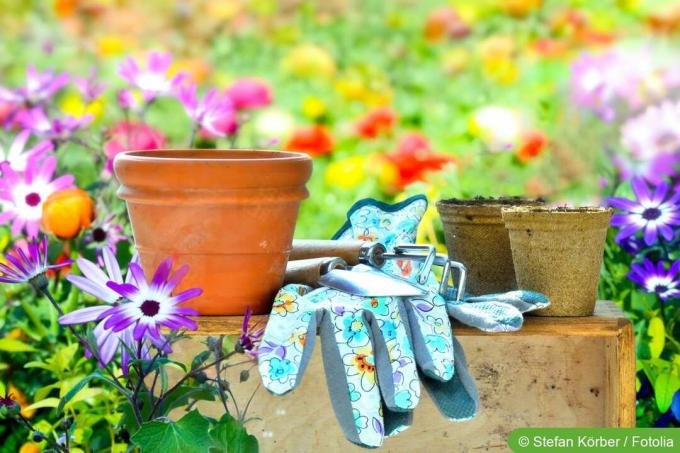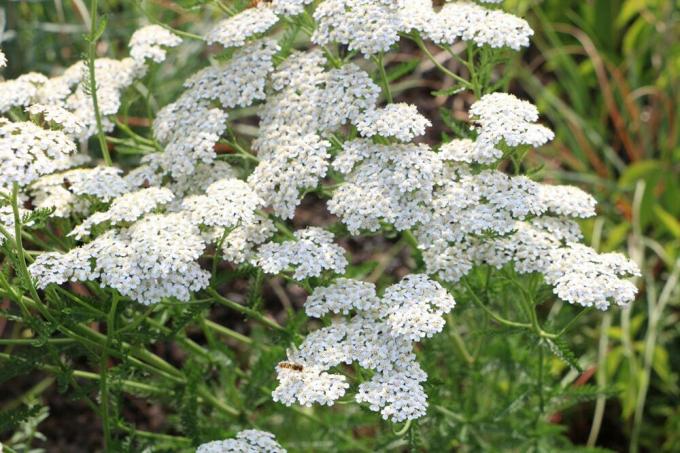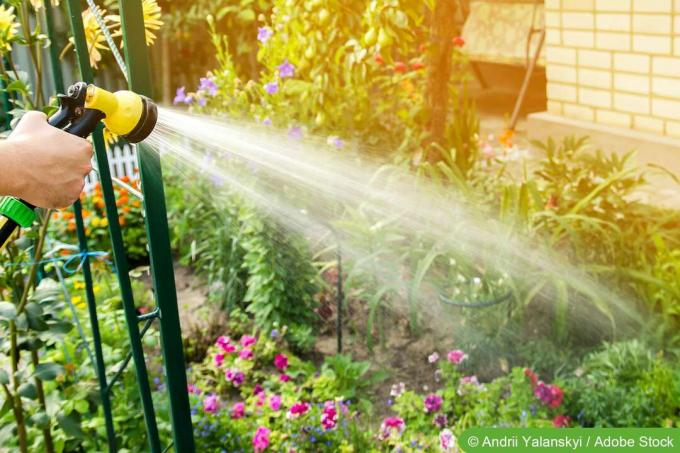

Table of contents
- Maintenance measures in June
- More gardening tips for June
- potatoes and other vegetables
- fruit trees and shrubs
- grape vines
- lawns and hedges
- Flower
- Tips for speed readers
In June, the garden unfolds in all its beauty. Something is blooming everywhere, the bushes and trees provide cool shade. Now the days are at their longest and there is always something to do. Even during the coffee break, the cup wanders into the garden, where it is often simply left somewhere to change something here and there, or to cut off something that has faded.
Maintenance measures in June
- Now is the ideal time to sow biennial summer flowers. June is also the best time for some perennials. It is best to sow in partial shade or shade so that the soil does not lose the moisture that the seeds need to germinate so quickly. Potted plants and some perennials that can be propagated by cuttings can now be cut and planted in a moist soil-sand mixture. A hood put over it ensures tense air, which promotes root formation.
- All hell broke loose in the rose bed in June. Many roses are already blooming at this time. A walk among the roses is a special experience. But even here there is enough to do. Faded flowers must be removed regularly, the roses must be checked for pests in order to be able to react as quickly as possible. But one should consider: It does not always have to be poison. A tried-and-tested household remedy helps to get rid of aphids quickly. The mixture of water, soft soap and a dash of spirit is quickly prepared, is effective and is also completely non-toxic.
- Potted plants need regular water and sufficient nutrients in summer. Some plants, such as brugmansia (angel's trumpets) are downright drunkards and eaters. They absolutely need water every day and fertilizer often too. The fertilizer favors the formation of buds and growth. Most potted plants also tolerate the high dose of fertilizer, so you can, provided there are no children and Pets come to the water butt, put the fertilizer directly into the water butt and all potted plants with this pour mixture.
- Everything is going its own way in the vegetable garden. You can still sow lettuce, lettuce and radishes, so you always have fresh supplies on a regular basis. It's still not too late to plant vegetables such as cucumbers, pumpkins, tomatoes, etc. In June, the lesser-known sheep cold is still to be expected. Observe weather conditions and, if necessary, protect vegetable plants (especially young vegetables) from the cold with foil or fleece.
- Freshly purchased potted plants should be left in a semi-shady place for a few days after purchase before being placed in the sun. The plants in the nurseries are rarely in the sun, they should get used to the new light conditions. However, if you plant them immediately, make sure that the soil remains moist. However, waterlogging should be avoided to avoid root damage.
- Regularly remove faded flowers from the perennial border. High-growing, late-flowering perennials, such as tall asters, cut back slightly in mid-June. The pruning makes the plants grow more compact, but the flowering does not stop. The cut stimulates shoot and bud formation. Perennials that have already faded can be cut off cleanly about 30cm above the ground. These will sprout again willingly and give us a second (albeit not so lush) bloom in late summer-early autumn.
More gardening tips for June
Berries are ripening, potato plants are growing rapidly, lawn care has to be practiced and the Rock garden needs care... There is a lot to do in June, but also the first one harvest fun. Ornamental gardens now need just as much care as kitchen gardens and fields. The garden is alive in June and it shows. The first ripe berries attract birds, pests infest the plants, and in the meantime next year's fruit tree blossoms have to be prepared.
potatoes and other vegetables
The potato plants grow very quickly in late May and early June. When they have reached a height of about 20 cm, they need to be piled up. In June, the Colorado potato beetle comes to many areas of Germany - it eats the leaves of the potato plant, which is so weakened that it hardly produces any potatoes. Very fine nets over the plants keep the beetles away in a biological way, but there are also appropriate pesticides.
Tomato plants are also quite high in June. In order for them to grow well, they must now be tied up. Avarice shoots are forming now. To protect the plants, the shoots should be carefully broken off as early as June, if possible without damaging the trunk. Otherwise, they take a lot of energy from the plants, which is lacking in the development of flowers and fruits.
Vegetables that are intended to be harvested twice a year must now be night sown. This applies to peas, beans, cabbage and beetroot. This seems early, but the plants need time to grow and mature. Even if it goes faster than the first sowing due to the higher temperatures and now very sunny days.
If planted early enough, cucumbers can be harvested as early as the end of June. However, this is rarely the case outdoors without a greenhouse. Cucumbers need to be pinched, that is, the shoots are shortened. The main shoot is usually cut after the sixth leaf, the side shoots after the seventh leaf. Due to the limited growth, the plant has more vigor and usually produces more fruit.
fruit trees and shrubs
Everything that bears fruit must be well watered in sunny and warm June. This also applies to trees and shrubs. Young plants in particular do not have such deep roots, they cannot reach the deeper, always water-bearing soil layers and are dependent on watering. Fruit trees and shrubs work hard in June and need to be fertilized to ensure a regular supply of nutrients. The trees are already bearing fruit. If there are too many, the fruit buds should be thinned out to ensure a high quality and safe harvest. Some trees put on too many fruits, they lack the strength to fully develop and ripen all of them.
Fruit trees are now being pruned so that they will flower profusely again next year. This is the so-called summer cut. And of course there is also harvesting: cherries, strawberries, gooseberries and currants are ripe in June. To prevent cheeky birds from stealing the ripe fruit, you should cover bushes and hedges with bird nets. This way you can really let the fruit ripen outdoors without suffering too serious a harvest loss. Of course, the fruits continue to ripen after they have been picked, but they may have less aroma.
Strawberry bushes also need attention now. Those that are to be renewed must be removed after harvest. Foothills are welcome to take root if they are desired. You should also remove those that are not needed for breeding. Because they take away the power of the plant. Remember to carefully loosen and rake the beds.
grape vines
There's a lot going on in June when it comes to wine. The shoots must be attached, stinging shoots can be carefully cut out. At least that's how it is traditionally - stinging shoots rob the plants of their strength, it was always said. Today we know that stinging shoots develop exactly the same organs as the other shoots, but a little smaller because they grow later. They promote the ripening of the grapes and should therefore be preserved. There is one exception: Where the strong foliage of the stinging shoots reaches into the grapes, you can carefully pinch out. This prevents fungal infections. Heavy foliage should be pruned in June anyway - for the reasons mentioned.
lawns and hedges
The lawn only needs to be mowed in June. Of course, during long periods of drought, it needs water so that it doesn't turn brown, but that's all there is to do.
Hedges are trimmed towards the end of June. Climbing shrubs now need to be tied to give them support. For roses that are reblooming, the withered flowers should be removed so that they do not produce fruit. Firstly, the development of fruit costs the plant energy and, secondly, it can reduce the number of further flowers. In the case of perennials, you should also remove the withered flowers - this applies in particular to perennials in the rock garden, the flowering period of which in many cases ends in June.
Flower
In June, the flowering plants are sown for the following year: forget-me-nots and pansies, columbines and mallow, foxgloves and carnations should flower in spring and summer of the following year. They can already be sown outdoors.
Tips for speed readers
- Pile up potato plants when they have reached a height of 20 cm and spread fine nets against the Colorado potato beetle in mid to late June.
- Tie up tomato plants and remove stinging shoots if necessary.
- Oversow peas, beans, beetroot and cabbage for the second crop of the year.
- Cucumbers are pinched out, the first early cucumbers can be harvested.
- Water fruit trees and shrubs well.
- Prune fruit trees for next year's flowering.
- For fruit trees that have many buds, remove some to allow the remaining fruit to fully develop.
- Cherries, strawberries, gooseberries and currants can be harvested. Cover shrubs and hedges with bird netting.
- Remove old strawberry plants after harvest, allow runners to root. Remove unneeded runners.
- Pinning vines. Cut back heavy foliage to prevent fungal infections.
- Remove vine shoots if the foliage is growing too close to the grapes.
- Mow the lawn and water when dry.
- Prune hedges towards the end of the month.
- Tie up climbing shrubs.
- On reblooming roses, remove wilted flowers to prevent fruiting.
- Remove wilted flowers from perennials (especially in the rock garden).
- Sow spring and summer flowering bulbs for next year.
 garden editorial
garden editorial I write about everything that interests me in my garden.
Learn more about gardening tips

Are hostas poisonous? | All information for humans & animals
Hostas, also called sweetheart lilies, can be planted out in the garden or kept in a bucket. They are considered easy to care for and are ideal for "dark" locations. Also, they are non-toxic, making them safe to cultivate in homes with children and/or pets.

Is yarrow poisonous? | Beware of confusion
Yarrow is a widespread herbaceous plant. The plant is very common on roadsides and in gardens and can be attractive to both animals and children. But the plant is harmless or poisonous. Here is the answer.

Remove Virginia creeper: the best remedies against clinging roots
Wilder Wein is a real climbing artist. Over time, it conquers the whole house with its foliage. But trying to get it off the wall is tedious, time-consuming and not always successful. What really helps?

Poisonous and non-toxic plants for horses - Attention poisonous plants
The horse has made itself indispensable as a sports partner, and its evolutionary survival seems assured. The poisonous plants that a horse can encounter in everyday life are becoming more and more diverse, they can even get into the hay or concentrated feed. A little information is therefore absolutely necessary so that a horse can go through its days as safely as possible; the article gives an overview.

Gardening Tips for November - Gardening Calendar
In November it's time to make the garden, balcony and terrace winter-proof. Potted plants that are not hardy should now be cut back and put away. The last vegetables are harvested in the vegetable garden. And by the way, leaves are being swept diligently. What else should you think about? We summarize the most important things.

Gardening Tips for July - Gardening Calendar
June was still busy in many areas, but things will calm down a little in some respects in July. Only those who have fruit trees can hardly save themselves from work now: the harvest is on. Which trees are cared for and how, what to do with the lawn and much more is in the garden calendar.
